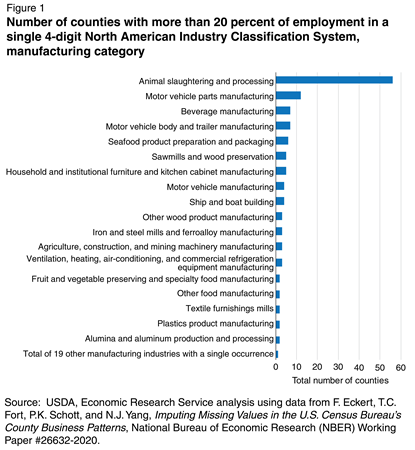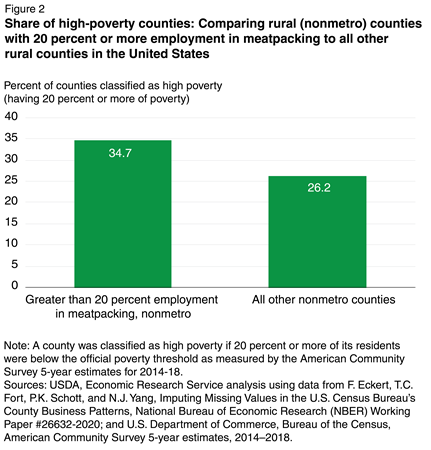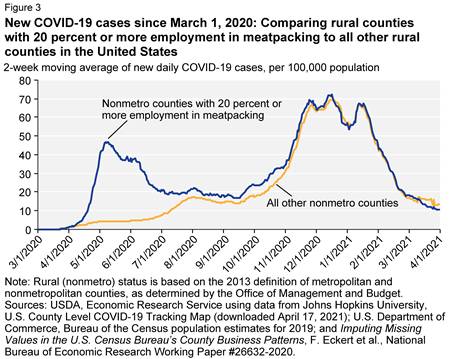
The Meatpacking Industry in Rural America During the COVID-19 Pandemic
Note: Updates to this page are discontinued. The material—last updated on May 13, 2021—remains on the site for reference.
There was increased attention to the meatpacking industry over the previous year as high rates of outbreaks of the coronavirus (COVID-19) last spring caused some meatpacking plants to temporarily shut down. Just over 500,000 people work in the meatpacking industry in the United States. Many plants are in cities such as Sioux Falls, SD, where meatpacking is just one of many major employers. However, several other plants are in much smaller municipalities such as Dakota City, NE, and Worthington, MN, where meatpacking is the primary employer in the county. There are 56 counties in the United States—49 in rural (nonmetro) counties and 7 in urban (metro) counties—where meatpacking is estimated to account for more than 20 percent of all county employment. While these counties make up 2.5 percent of all rural counties and 0.6 percent of urban counties, they represent 19.0 percent and 2.9 percent, respectively, of all meatpacking employment in the United States.
The employment dependence of these counties on a single industry makes meatpacking—officially termed "animal slaughtering and processing" in the North American Industry Classification System (NAICS)—a unique industry in the United States. The uniqueness of the employment concentration of the meatpacking industry (NAICS 3116) can be placed into context by examining the other 85 manufacturing industries categorized at the NAICS four-digit industry level. There are only 91 other counties in the United States where a manufacturing industry accounts for at least 20 percent of county employment. Motor vehicle parts manufacturing is the next highest industry with the number of counties with at least 20 percent of employment in a single industry, with only 12 counties, compared with the 56 meatpacking-dependent counties.
Even before the outbreak of COVID-19, the 49 rural meatpacking-dependent counties were facing a comparatively high prevalence of poverty. ERS defines high-poverty counties as those with poverty rates of 20 percent or higher, using the 2014–18 pooled 5-year estimates of the American Community Survey. Using this definition, 34.7 percent of these meatpacking-dependent counties were defined as high-poverty counties, compared with 26.2 percent in all other rural counties in the country.
Data on confirmed COVID-19 cases as of April 17, 2021—from the Johns Hopkins University U.S. County Level COVID-19 Tracking Map—show that in early April 2020, when the first plant closures occurred, there was little difference in the number of confirmed cases per 100,000 population between these meatpacking-dependent counties and all other rural counties. Starting in mid-April, confirmed cases per 100,000 in rural meatpacking-dependent counties grew rapidly.
The two-week moving average number of new daily cases rose in meatpacking-dependent counties through the remainder of April 2020, reaching a peak of nearly 50 cases per 100,000 by the end of the month. This two-week moving average was more than 10 times the prevalence seen in other rural counties. Even though cases in meatpacking-dependent counties started to decline in the month of May, they remained significantly higher compared with other rural counties, falling to just under seven times the number of average daily cases by the end of May.
Partial plant closures and increased social distancing protocols were implemented at meatpacking plants across the country starting in late April 2020 through early June. These preventative measures might have influenced infection rates, as June saw the beginning of a sharp reduction in the number of new cases per 100,000 for these meatpacking-dependent counties, appearing to plateau in July. Both meatpacking-dependent and other rural counties saw modest declines in the two-week moving average number of new daily cases per 100,000 from August through mid-September. Starting in mid-September, all rural counties started experiencing a surge in average new cases per 100,000.
All rural counties observed a new high in cases in December 2020. While this represented a first peak for most of rural America, it was the second for meatpacking-dependent rural counties, more than 1.5 times higher than during the initial outbreak from April. Even though meatpacking-dependent counties were dealing with a second wave, the surge in rural new cases did not appear to be driven by new outbreaks in the meatpacking industry, given how closely these counties continued to track compared to all other rural counties. Meatpacking-dependent counties have maintained an almost identical pattern to other rural counties for the last nine months. Since November, meatpacking-dependent counties have averaged less than half a percent higher two-week moving average number of new daily cases per 100,000 people compared with all other rural counties.
All rural counties started observing a sharp decline in January 2021. This reduction is likely associated with availability of vaccines within these communities. Meatpacking-dependent counties are observing the lowest COVID-19 two-week moving average number of new daily cases per 100,000 since mid-April of 2020. For added context, that was around the time when the outbreaks were starting to become widespread at meatpacking plants across the country.




